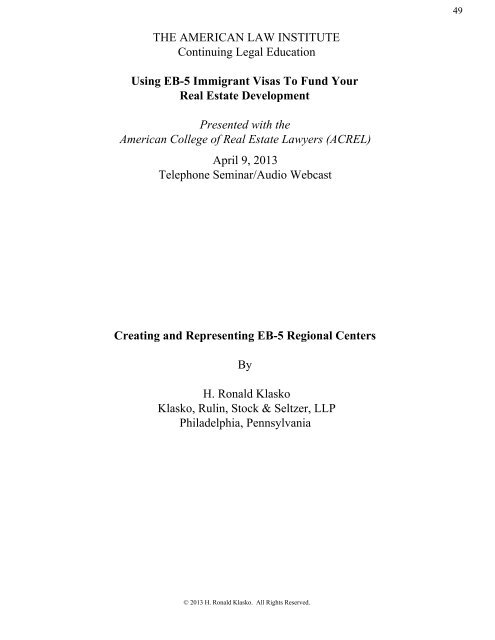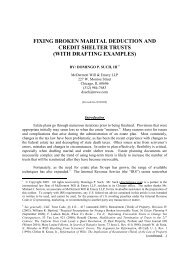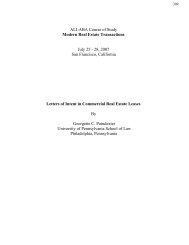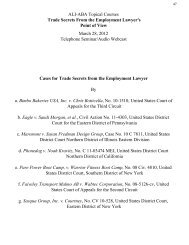Creating and Representing EB-5 Regional Centers - ALI CLE
Creating and Representing EB-5 Regional Centers - ALI CLE
Creating and Representing EB-5 Regional Centers - ALI CLE
- No tags were found...
You also want an ePaper? Increase the reach of your titles
YUMPU automatically turns print PDFs into web optimized ePapers that Google loves.
49THE AMERICAN LAW INSTITUTEContinuing Legal EducationUsing <strong>EB</strong>-5 Immigrant Visas To Fund YourReal Estate DevelopmentPresented with theAmerican College of Real Estate Lawyers (ACREL)April 9, 2013Telephone Seminar/Audio Webcast<strong>Creating</strong> <strong>and</strong> <strong>Representing</strong> <strong>EB</strong>-5 <strong>Regional</strong> <strong>Centers</strong>ByH. Ronald KlaskoKlasko, Rulin, Stock & Seltzer, LLPPhiladelphia, Pennsylvania© 2013 H. Ronald Klasko. All Rights Reserved.
50<strong>Creating</strong> <strong>and</strong> <strong>Representing</strong> <strong>EB</strong>-5 <strong>Regional</strong> <strong>Centers</strong>By H. Ronald Klasko 1IntroductionThe <strong>EB</strong>-5 program was implemented in 1990 as a program to provide legal permanent residence status toinvestors who invest $500,000 or $1 million (depending on the geographical area) in a business thatcreates employment for 10 full-time U.S. citizen or permanent resident employees. 2 For various reasons,especially that fact that most businesses do not commence early operations with 10 full-time employees,Congress created the regional center program in 1993. A regional center is “any economic unit, public orprivate, which is involved with the promotion of economic growth, including export sales, improvedregional productivity, job creation, <strong>and</strong> increased domestic capital investment.” 3 Today, regional centerpooled <strong>EB</strong>-5 investments constitute over 90 percent of the total <strong>EB</strong>-5 petitions.From the investor’s point of view, the major advantage of a regional center investment is that theinvestor’s petition can be approved as long as the regional center project creates 10 direct or indirect jobs.This allows regional centers to use economic forecasting models to project indirect <strong>and</strong> inducedemployment created as a result of the new project. The main disadvantage of a regional center for aninvestor is that the investment amount is being put toward a project that the investor does not control <strong>and</strong>generally the investor will not be working in the project in which he invests. In addition, he will bepaying the regional center developer a sum of money (often between $30,000 <strong>and</strong> $70,000) to cover thedeveloper’s expenses <strong>and</strong> profit.1 H. Ronald Klasko (Ron) (rklasko@klaskolaw.com) is one of the country's leading lawyers representing developers<strong>and</strong> investors in <strong>EB</strong>-5 cases. He has been the Chair of the <strong>EB</strong>-5 Committee of the American Immigration LawyersAssociation for the past 3 years. In that capacity, he leads the advocacy efforts of immigration attorneys around theworld relating to improving <strong>EB</strong>-5 legislation, regulations <strong>and</strong> adjudications. Ron represents two of the three largestregional centers <strong>and</strong> is a designated preferred attorney for filing <strong>EB</strong>-5 petitions for many of the approved regionalcenters. He also regularly works with developers creating new regional centers <strong>and</strong> with investors investing inregional center <strong>and</strong> individual projects. Ron is a founding member of Klasko, Rulon, Stock & Seltzer, LLP <strong>and</strong>serves as its Managing Partner. He has practiced immigration law exclusively for over three decades. Under hisleadership, the firm has been chosen with four other firms by Chambers Global as the top U.S. business immigrationlaw firms. Ron, himself, was named as one of the top two most respected corporate immigration lawyers in theworld for the last five years by the International Who's Who of Business Lawyers.2 8 U.S.C. § 203(b)(5).3 8 CFR § 204.6(e).
51<strong>Creating</strong> <strong>and</strong> <strong>Representing</strong> <strong>EB</strong>-5 <strong>Regional</strong> <strong>Centers</strong>Most, but not all, of the regional center projects are real estate-based projects. With capital becomingunavailable from traditional sources, <strong>EB</strong>-5 money is becoming an important alternative source of capital.As a result, the number of regional centers has increased more than sixfold in the past three years.From the developer’s point of view, regional center certification provides an aura of legitimacy that mayhelp in marketing to foreign investors. In addition, a particular regional center project may bepreapproved by USCIS. <strong>Regional</strong> center designation is a one-time designation allowing future projects tobe marketed without incurring delays. In addition to funding their own projects, regional centers canprofit by sponsoring <strong>and</strong> overseeing projects developed by others.However, seeking regional center designation does have some disadvantages. <strong>Regional</strong> centercertification may take a lengthy period of time – presently 6 months or longer. <strong>Regional</strong> centercertification may entail significant expense, including hiring multiple professionals as will be discussedbelow. <strong>Regional</strong> center certification is not the same as approval of any particular regional center project.With so many regional centers approved, many regional centers have not been able to attract investors;<strong>and</strong> some newer regional centers find it difficult to compete in their marketing efforts with long-existingregional centers with a track record of many immigration approvals. Finally, regional centers haveongoing administrative <strong>and</strong> filing requirements with USCIS in order to avoid decertification.Other Options for Raising Capital under <strong>EB</strong>-5 ProgramA developer might consider three other options for raising capital under the <strong>EB</strong>-5 program:• Having a project “adopted” by a certified regional center;• Purchasing a certified regional center; or• Pooling investments with individual <strong>EB</strong>-5 petitions.Having a project adopted by an existing regional center saves the time <strong>and</strong> expense involved indeveloping a new regional center. The existing regional center may have a marketing plan in place, <strong>and</strong>may even have existing investors ready to invest. Furthermore, project pre-approval is available.However, some of the developer’s profit will be siphoned off to the regional center operators.Furthermore, the developer needs to do serious due diligence with respect to the regional center to makecertain that the developer is not affiliating with a regional center that may have a bad reputation in themarketplace or that may be at risk of decertification.Some developers have chosen to purchase an existing (sometimes dormant) regional center. Once anagreeable price is reached, the developer does not need to negotiate away profit or control with respect toany particular project. However, as with purchasing any other business, the developer needs to do seriousdue diligence regarding potential liabilities <strong>and</strong> negative good will.Of course, there is no need for a developer to work through a regional center at all. If the project willcreate 10 full-time employees for every investor, the investors can invest without the developer creating aregional center. This eliminates serious time delays <strong>and</strong> expenses, as well as ongoing administration.Klasko, Rulon, Stock & Seltzer, LLP Page 2 of 8
52<strong>Creating</strong> <strong>and</strong> <strong>Representing</strong> <strong>EB</strong>-5 <strong>Regional</strong> <strong>Centers</strong>However, the option of project pre-approval is not currently available. Also, marketing to foreignnational investors may be more difficult without the aura of regional center designation.<strong>Creating</strong> a <strong>Regional</strong> CenterIn order to create a regional center, it is necessary to put together a team of professionals:• An <strong>EB</strong>-5 Economist is a critical professional in performing the economic projection ofindirect <strong>and</strong> induced jobs; helping to establish a targeted employment area (“TEA”); <strong>and</strong>helping to determine the geographic bounds of the regional center• A Securities/Corporate Attorney is necessary because the regional center investmentoffering is subject to securities laws. The securities attorney will prepare the privateplacement memor<strong>and</strong>um, including specific immigration risks of the investment, as well asthe Subscription Agreement. Usually the same attorney will create two or three corporateentities – the regional center entity; the “new commercial enterprise;” <strong>and</strong> sometimes theseparate job-creating entity.• The <strong>EB</strong>-5 Business Plan Writer will be preparing the comprehensive business plan topresent a credible explanation of the project, the use of the capital, the timelines, the jobcreation <strong>and</strong> other aspects of the project. Sometimes, the <strong>EB</strong>-5 business plan writer will alsoprepare an operating plan for the regional center.• The Immigration Attorney generally acts as the “quarterback” of the professional team. Heneeds to ensure consistency between the business plan <strong>and</strong> economic report; make certainthat the business plan is in conformity with USCIS policy; make certain that job creation isboth underst<strong>and</strong>able <strong>and</strong> credible <strong>and</strong> consistent with USCIS policy; provide advice regardingimmigration risks for the private placement memor<strong>and</strong>um; review all documents forimmigration compliance; prepare <strong>and</strong> file the regional center designation application; prepare<strong>and</strong> file any application for project pre-approval; <strong>and</strong> in some cases prepare <strong>and</strong> file theinvestors’ I-526 <strong>EB</strong>-5 petitions.• Marketing Firm/Commissioned Agents are a critical part of the process because all of thework done by the other professionals will be for naught unless the project can be successfullymarketed to investors.• A Bank/Escrow Agent is often a part of the process since many regional centers offer aprotection to investors of having the investment amount sit in an escrow account at a bank,not to be released until the <strong>EB</strong>-5 petition is approved.Issues for <strong>Regional</strong> <strong>Centers</strong>Two of the most important initial issues to be addressed are:• How much must investors invest?• How much capital can be raised?Klasko, Rulon, Stock & Seltzer, LLP Page 3 of 8
53<strong>Creating</strong> <strong>and</strong> <strong>Representing</strong> <strong>EB</strong>-5 <strong>Regional</strong> <strong>Centers</strong>Virtually all regional center investments are $500,000 investments. The reason is that the projects are in“targeted employment areas” (TEAs) 4 . As a practical matter, if a project is not in a TEA, the chances ofsuccess for marketing of the project to foreign investors are rather slim.There are three ways to prove that the investment project is in a TEA:• If the project is in a “rural” area, which is defined as outside of a metropolitan statistical areawith a population of 20,000 or more, it qualifies as a TEA 5 ;• If the project is in a census tract with an unemployment rate of at least 150% of the nationalaverage, it qualifies as a TEA; or• If the economist is able to aggregate a number of contiguous census tracts which togetherhave an average unemployment rate of at least 150% of the national average, <strong>and</strong> if thedesignee of the governor of the state provides a letter designating the aggregated census tractarea as a TEA, USCIS will generally defer to the state designation 6 .It is important to note that the ultimate TEA designation is not made until each investor makes hisinvestment 7 . Therefore, a developer risks the possibility that a project could commence at a time whenthe geographical area is a TEA; but by the time investors actually invest, it may not be a TEA.The amount of <strong>EB</strong>-5 capital that can actually be raised for a project is obviously a critical issue. Thatamount is based on how many direct, indirect <strong>and</strong> induced jobs will be created. Ultimately, the maximumnumber of investors is determined by dividing the job creation projection by 10. Multiplying that numberof investors by $500,000 (assuming a TEA) provides the maximum <strong>EB</strong>-5 capital raise. As a practicalmatter, investors will generally want to see that the job creation is far more (20-30% more) than theminimum required.It is thus rather obvious that the economic job projection report is a critical document. Generally,economists will use one of four recognized “input-output models;” RIMS2, REDYN, REMY <strong>and</strong>IMPLAN. These models project indirect <strong>and</strong> induced employment generally within the geographicbounds of the regional center. However, although USCIS has equivocated on the issue, it now appears tobe recognized that indirect <strong>and</strong> induced employment can be created outside of the regional centergeographic boundaries if a credible case can be made as to why other areas of the country will benefit.The immigration attorney, although presumably not an expert economist, should not just accept theeconomic report in an unquestioning manner. The immigration attorney should consider the followingkey issues in his review of the economic report:4 8 CFR § 204.6(e).5 8 CFR § 204.6(j)(6)(i).6 8 CFR § 204.6(j)(6)(ii).7 8 U.S.C. § 203(b)(5)(B)(ii).Klasko, Rulon, Stock & Seltzer, LLP Page 4 of 8
54<strong>Creating</strong> <strong>and</strong> <strong>Representing</strong> <strong>EB</strong>-5 <strong>Regional</strong> <strong>Centers</strong>• It must be completely consistent with the business plan. The economic report will be premisedupon certain input projections, which must come from the business plan, such as expenditures,revenues, direct employees, square footage, occupancy rate, etc.• The immigration attorney must make certain that the economic report is “transparent.” In otherwords, it should be clear from reading the report how the economist extrapolated job projectionfrom the specific foundation facts.• The immigration attorney must be concerned with a projected timeline for job creation. USCISpolicy is that the requisite employment must be created within two <strong>and</strong> half years of <strong>EB</strong>-5 petitionapproval.• The immigration attorney should be concerned with overly aggressive “inputs.” If the aggressiveestimates are not met, some or all of the investors may not be able to get their conditions removed(see below).• The immigration attorney must make certain that the economist underst<strong>and</strong>s the differencebetween a “direct” job as defined by USCIS <strong>and</strong> what an economist normally considers to be adirect job. An economist may consider an employee of the construction company or of theconstruction project or target business to be a direct employee. However, the USCIS definition ofemployee is a W-2 employee of the “new commercial enterprise” in which the investor actuallyinvests 8 . Often, this enterprise is different than the job-creating enterprise.In reviewing the <strong>EB</strong>-5 business plan, the immigration attorney should be concerned with whether the planis credible <strong>and</strong> whether it is consistent with the economic report. The timelines specified in the businessplan are critical. Often, the immigration attorney will advocate for a business plan that is not too specificin order to avoid the possibility that the specifics of the business plan are not adhered to, which can raiseissues of “material change” at the condition removal stage (see below).The geographic scope of the regional center often involves several considerations. If the scope is toolarge, it may be difficult to get the regional center designation approved, as USCIS may consider the areanot to be a definable “region.” If it is too small, there may be a need to amend the regional centerdesignation if a future project falls outside of the initially designated area. The economist can assist indetermining the largest possible area that can be justified as an economically interdependent region. Inthis regard, it is important to underst<strong>and</strong> that there is no exclusive jurisdiction for regional centers.In most cases, there are three different entities involved in the regional center creation process:• The regional center itself is an administrative entity that applies to USCIS for certification. It hasongoing administrative <strong>and</strong> compliance responsibilities, markets for investors, performs duediligence regarding the investor’s source of funds <strong>and</strong> oversees the preparation of the investors’<strong>EB</strong>-5 petitions. The regional center entity also obtains signed Subscription Agreements <strong>and</strong>Escrow Agreements; monitors employment creation; tracks infusion of capital into the jobcreatingenterprises; monitors compliance with the business plan <strong>and</strong> the foundation facts onwhich the economic report is based; allocates jobs between investors; prepares an annual8 8 CFR § 204.6(e).Klasko, Rulon, Stock & Seltzer, LLP Page 5 of 8
55<strong>Creating</strong> <strong>and</strong> <strong>Representing</strong> <strong>EB</strong>-5 <strong>Regional</strong> <strong>Centers</strong>reporting for filing with USCIS; oversees the preparation of condition removal packages forapproved investors; <strong>and</strong> decides on new projects. Generally, an operational plan is prepared forthe regional center. The operational plan often includes an overview of the regional center;information about marketing plans <strong>and</strong> recruitment of investors; explanation of the funding <strong>and</strong>budget for the regional center; explanation of the systems to be used for administrative oversight.• The “new commercial enterprise” is the entity into which the investor invests. This is generally alimited partnership or LLC. In all cases, the investors make equity investments into the newcommercial enterprise. In many cases, the new commercial enterprise is in the business ofloaning money to one or more job-creating enterprises. In fewer regional centers, the investors inthe new commercial enterprise take an equity stake in the development project.• The job-creating enterprise is the actual development project or business. In the model where thenew commercial enterprise loans money, the job-creating enterprise is the borrower. Repaymentof the loan with interest provides the exit strategy <strong>and</strong> rate of return for the investors.<strong>Regional</strong> Center Application ProcessWith all of that as background, the immigration attorney is ready to prepare the application for regionalcenter designation. The application is made on Form I-924 with a volume of additional documentation.Generally, the documentation will include most or all of the following:• A detailed map illustrating the contiguous geographical area of the proposed regional center,together with an explanation regarding the economic interdependency of the region;• Economic projection of job creation;• Business plan;• NAICS code for each industrial category;• Documentation of TEA;• Operational plan for the regional center;• Marketing plan;• Organizational structure <strong>and</strong> budget of the regional center;• Statement from the principal of the regional center that explains the methodologies that theregional center will use to track the infusion of each investor’s capital into the job-creatingenterprise <strong>and</strong> to allocate the jobs created;• Draft Subscription Agreement;• Draft Private Placement Memor<strong>and</strong>um;• Draft Escrow Agreement;• Corporate documentation for the regional center;• Hard copy of any marketing materials;Klasko, Rulon, Stock & Seltzer, LLP Page 6 of 8
56<strong>Creating</strong> <strong>and</strong> <strong>Representing</strong> <strong>EB</strong>-5 <strong>Regional</strong> <strong>Centers</strong>• Plans to remain in compliance with ongoing USCIS monitoring requirements;• Proof of the investor’s involvement in the business;• Procedure the regional center will use to perform due diligence on the source of funds of theinvestors; <strong>and</strong>• Documentation of community or political support.At the same time as the regional center requests designation, it can also file an application for preapprovalof its initial project. This procedure is completely optional, <strong>and</strong> investors can file I-526 <strong>EB</strong>-5petitions without project pre-approval. Also, project pre-approval can be filed independently forsubsequent projects. If the regional center opts for project pre-approval, it must file a complete packagecontaining everything that would be required in an investor’s I-526 petition except the investor’s sourceof funds <strong>and</strong> path of funds.The advantages of project pre-approval are the possibility of avoiding multiple adjudications of projects<strong>and</strong> a clear marketing advantage. The disadvantages are that project pre-approval can add significant timeunless it is filed concurrently with the I-924 form. Also, USCIS examiners often disregard the preapproval.Assuming the regional center designation is approved, <strong>and</strong> the marketing effort is successful, thedevelopers want to know when the money will actually be available for the project. Generally, theinvestor must invest 100% of the investment before the I-526 petition is filed. The developer has theoption of either using the money immediately or putting the money into escrow to be released when theinvestor’s I-526 petition is approved. Either option is fully compliant with <strong>EB</strong>-5 rules <strong>and</strong> policies, butthe latter certainly provides a marketing advantage.Because of the substantial processing time to obtain the regional center designation, particular project preapproval(if requested) <strong>and</strong> approval of the investor’s <strong>EB</strong>-5 petition, developers often obtain interim orbridge financing to enable the project to move forward pending receipt of the <strong>EB</strong>-5 capital. The <strong>EB</strong>-5capital then often replaces the bridge financing. This is normal business practice <strong>and</strong> should not create anissue for <strong>EB</strong>-5 petition approval, because it is the new commercial enterprise (<strong>and</strong> not the investor) thatmust create the jobs. However, some USCIS adjudicators have questioned whether the <strong>EB</strong>-5 moneyactually creates the jobs in this scenario.Another sometimes controversial issue involves the requirement that the investment must be “at risk.” 9This principle prevents an investor from being assured of a guaranteed redemption at a specific price.Redemption at fair market value is acceptable. Third party guarantees of the investment have beenallowed. The issue of third party insurance provided by the regional center is an unresolved one.In addition to dealing with investors, regional centers have ongoing reporting requirements. Every year,the investor must file form I-924 A providing, inter alia, the total amount of <strong>EB</strong>-5 capital invested; the9 Matter of Izummi, 22 I&N Dec.169 (Assoc. Comm’r, Examinations 1998).Klasko, Rulon, Stock & Seltzer, LLP Page 7 of 8
57<strong>Creating</strong> <strong>and</strong> <strong>Representing</strong> <strong>EB</strong>-5 <strong>Regional</strong> <strong>Centers</strong>amount of job creation; the industry focus; the number of approved <strong>and</strong> denied I-526 petitions; <strong>and</strong> thenumber of approved <strong>and</strong> denied I-829 petitions.Certain changes in regional center operations could result in a need for a regional center to seek anamendment of its designation on Form I-924. These include:• Exp<strong>and</strong>ing geographical boundaries;• Adding new industry designations;• Changing economic methodologies.Once all of the investors’ <strong>EB</strong>-5 petitions are approved, the regional center’s job is not done. Within thewindow of 21 to 24 months after each investor’s conditional permanent residence is approved, theinvestor must file an I-829 petition to remove the conditions on permanent residence <strong>and</strong> become a fullpermanent resident. In order to get that petition approved, the investor must prove that he has sustainedhis investment, that there has been no “material change” in the business plan <strong>and</strong> that the projected jobshave been created 10 . The latter two issues require amplification.The concept of material change is a controversial one. The USCIS position is that, even if all requisitejobs have been created, conditions will not be removed if there has been a material change in the businessplan 11 . What a material change is remains undefined. It is therefore critical for the regional center toprepare its business plan in such a manner as to minimize the risk that a material change could jeopardizethe ultimate permanent residence status of its investors.It is certainly best if the regional center can prove that all of the projected direct jobs have occurred <strong>and</strong>that all of the foundation facts that provided the input for the economist’s projection of indirect <strong>and</strong>induced jobs have actually occurred. What if all of the jobs have not actually occurred by the time of thefiling of the condition removal petition? The USCIS regulation allows for proof that the jobs will becreated “within a reasonable time” from the date of filing of the condition removal petition 12 .The regional center <strong>EB</strong>-5 option is a classic win-win-win program. Developers are able to move forwardwith projects that otherwise might not have sufficient financing; jobs are created; <strong>and</strong> investors get greencards. However, the program remains a “pilot program” that needs to be renewed by Congress at variousintervals 13 . Efforts are underway to get Congress to make the program permanent, which would likelyspur its growth well beyond present levels.10 8 CFR § 216.6(c).11 USCIS Adjudicator’s Field Manual § 22.4.12 8 CFR § 216.6(c)(1)(iv).13 Departments of Commerce, Justice, <strong>and</strong> State, the Judiciary, <strong>and</strong> Related Agencies Appropriation Act of 1993,Pub. L. No. 102-395, § 610,106 Stat. 1828, S. Rep. No. 102-918 (1992).Klasko, Rulon, Stock & Seltzer, LLP Page 8 of 8
582
















